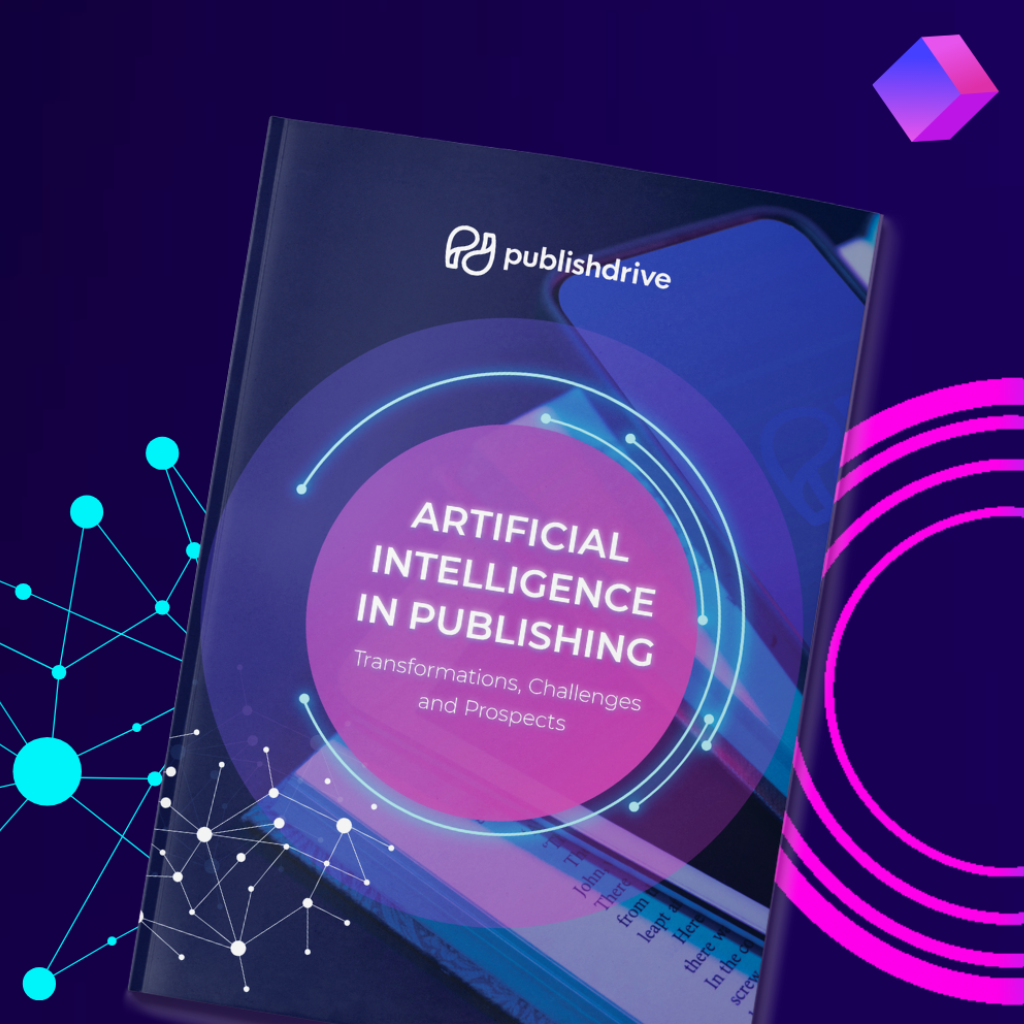AI for Publishers: How to Harness AI in the Publishing World

Living in this fast-paced era of digital everything means being ready to adapt to the ever-changing trends, tools, and, of course, the impact of AI. This applies to the publishing industry, too.
But adaptability doesn’t mean something negative.
On the contrary.
Being able to adapt to AI trends means getting better at automating some processes while focusing on your business development and keeping the human touch authors need.
Content creation, distribution, and marketing are experiencing a significant shift as AI book publishing becomes more popular.
So, how can you leverage AI in publishing?
PublishDrive conducted a survey and gathered insights from more than 250 authors and publishers on the influence of Artificial Intelligence in publishing. The survey shows the adoption of AI in publishing when it comes to content creation and marketing, but also the need for ethical standards in using AI.
Download the survey here:

Key Takeaways:
- From content curation and marketing to editing and inventory management, AI tools analyze vast amounts of data to streamline processes and make data-driven decisions.
- Publishers can use AI to target specific audiences with tailored marketing campaigns and create personalized reading experiences in the future.
- AI helps with tasks and offers valuable insights, but the human element is still irreplaceable.
AI for Publishers: How to Use It in Book Publishing
AI can assist book publishers in various stages of the publishing process, including choosing, distributing, and promoting their books, showing unprecedented opportunities.
Here's how:
1. Topic curation
The future of publishing is now. AI algorithms can analyze vast amounts of data, including reader preferences, market trends, and historical sales data, to identify potential bestselling topics or genres and help publishers with editorial decisions.
Publishers can use AI tools to predict which manuscripts are likely to perform well in the market, helping in the selection process and creating personalized content.
This data-driven approach guides decisions on acquisitions, content strategies, and distribution channels.
AI can analyze consumer behavior, social media trends, and demographic data to identify target audiences for specific books. Publishers can use this information to tailor their marketing strategies and reach potential readers more effectively.
Tools for this stage:
- Nielsen BookScan: Forget guesswork; Nielsen BookScan equips you with real sales data from bookstores, online retailers, and other outlets. Analyze market trends and pinpoint the exact demographics devouring specific genres to refine your publishing strategy.
- OpenAI: Language models like GPT-4 can be your brainstorming partner. These AI tools analyze market trends, providing valuable insights to help you with your next bestseller.
- Quantifind: Uses AI to analyze consumer behavior and social media trends to identify target audiences and market trends. It provides insights derived from unstructured data sources, such as text data from social media, customer reviews, news articles, and other online content.
- Meltwater: Meltwater acts as your AI-powered news hub, monitoring social media discussions, news articles, and web content across various sources. It helps you set up customized searches, track brand mentions, analyze media coverage, and identify potential influencers.
2. Marketing campaigns based on backlists
As publishers, you can use AI to revive your backlist. Connect older books to newer books and reinvigorate backlist marketing across thousands of books and journals.
AI algorithms can analyze reader data to identify audiences who are likely to be interested in specific backlist titles based on their reading preferences and behavior.
Publishers can then create targeted marketing campaigns to reach these audiences through email, social media, or online advertising, increasing awareness and driving sales of backlist titles.
Once you know who your audience is, use PublishDrive’s book marketing options to increase your title’s chances of being discovered. Authors that used the available promotions saw a significant increase in sales. Read about their success stories. Also, here’s how easy it is with PublishDrive:
3. Editing and proofreading
AI-powered editing and proofreading tools can help publishers in the editing process. These tools can scan manuscripts for typos, grammar mistakes, and any inconsistencies in the writing.
This helps editors in two ways: first, it improves the overall quality of the final book by catching errors. Second, it saves editors time and resources that they can then dedicate to other important tasks in the editing process.
💡 Keep in mind: Many publishers use a hybrid approach to combine AI's speed with human editors' creativity and quality. Artificial Intelligence in publishing is revolutionary, but some processes still need to pass human review.
Tools for this stage:
- Marlowe: Marlowe analyzes your manuscript in just 15 minutes, offering feedback on character development, story pacing, and repetitive words. It's like having a second set of eyes catch inconsistencies before publication.
- Grammarly: An AI-powered writing assistant that checks for grammar, spelling, punctuation, and style mistakes.
- ProWritingAid: Offers suggestions for improving style, readability, and consistency in writing.
4. Book format repurposing
AI in publishing can help with content repurposing. Authors and publishers can create audiobooks from existing ebooks to cut the time and cost of production. Plus, with generative AI, they can create book covers faster.
Text-to-speech (TTS) systems are examples of how AI is making a difference. Using Natural Language Processing (NLP) algorithms, these systems turn written text into spoken words, making audiobooks and AI publishing go hand in hand.
Tools for this stage:
At the moment, all big five book retailers (Barnes & Noble, Google Play Books, Apple Books, Amazon, Kobo) have developed their own digital narration feature. This means ebooks distributed through these platforms can be turned into audiobooks.
How to Use Apple Books Digital Narration via PublishDrive
As one of Apple Books’ trusted partners, you can submit your ebook to Apple’s audio program with just a few clicks on PublishDrive.
- If you’re already on PublishDrive: Go to your ebook settings and enable the channel under the stores distribution list. Your book gets submitted right away.
- If you’re not on PublishDrive: Sign up, upload your ebook files, and enable the channel at the very last step of your setup (and don’t forget to enable the rest of PublishDrive’s stores.)
Note: Audiobooks created with Apple’s Digital Narration can be distributed only on Apple Audiobooks, and if you use Apple Books digital narration, you agree that Apple owns all rights, titles, and interests in and to the audiobooks created with Apple Books digital narration.
To learn more, see this guide on Apple Books Digital Narration.
5. Dynamic pricing strategies
The role of AI in publishing can be important if used correctly. For example, AI can analyze pricing data, competitor pricing strategies, and market demand to recommend optimal book pricing strategies.
Publishers can adjust prices based on various factors such as demand, seasonality, and competitors to maximize revenue and profitability.
💡Penguin Random House uses AI with machine learning to set the selling price of an ebook or to determine the starting print run of printed books: “At Penguin Random House, we’ve been working with artificial intelligence for more than a decade in different countries and different areas, primarily with machine learning, for example, to set the selling price of an e-book or to determine the starting print run of printed books. And wherever we have combined human activity and AI, it has led to better results.” – Nihar Malaviya, CEO of Penguin Random House
Tools for this stage
- Wiser: This innovative platform uses advanced analytics to understand real-time market trends, competitor pricing, and customer behavior. Wiser helps you set optimal pricing strategies and curate the perfect inventory selection.
6. Social media and sentiment analysis
Publishers can use AI in the publishing industry to monitor social media platforms and online forums. This helps analyze reader reactions and sentiments toward specific books, helping them to fine-tune their marketing messages, identify potential issues early, and engage with readers more effectively.
Tools for this stage:
- Sprinklr: Managing social media can be a juggling act. Sprinklr simplifies it with AI. This is an AI-powered social media management platform that monitors brand mentions across various social channels, analyzes audience sentiment, and automates repetitive tasks. Sprinklr equips you with actionable insights so you can craft a winning social media strategy. This translates to increased engagement, improved customer satisfaction, and achieving your marketing goals.
7. Better inventory management
Publishers need to stay ahead of the curve by aligning their content strategy with expected demand. For example, if data shows a growing interest in historical fiction, publishers can concentrate on acquiring and promoting books in this genre.
Managing inventory efficiently is a top priority for publishers. Here is where AI and book publishing can coexist in a beneficial way.
AI's predictive analytics help optimize inventory by ensuring that publishers produce or acquire the right number of books to meet projected demand.
This minimizes the risks of overstocking or understocking.
Wrapping Up
AI for publishers is revolutionizing the industry by providing powerful tools to analyze reader preferences, predict market trends, and optimize content strategies for maximum impact.
The integration of AI in book publishing offers publishers new opportunities to optimize their operations.
By using AI-powered tools such as natural language processing, generative AI, and real-time analytics, publishers can streamline content creation, personalize marketing campaigns, and make data-driven editorial decisions.
While AI enhances efficiency and effectiveness, it's essential to maintain the human touch in the publishing process, ensuring that creativity and quality remain central to the industry's evolution.